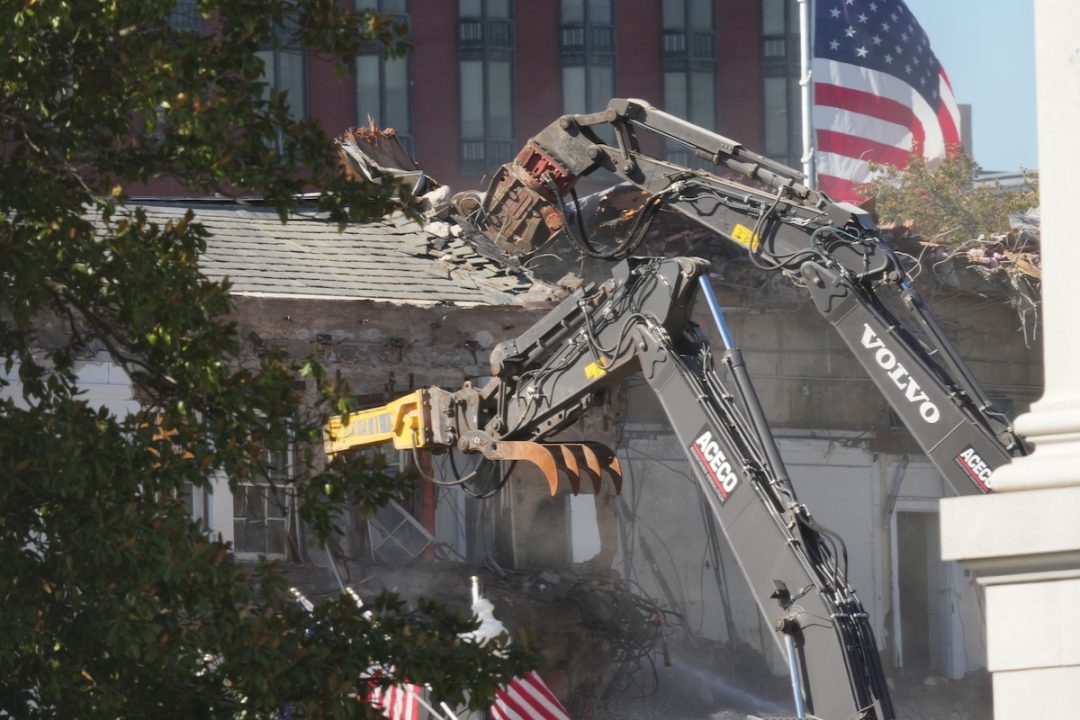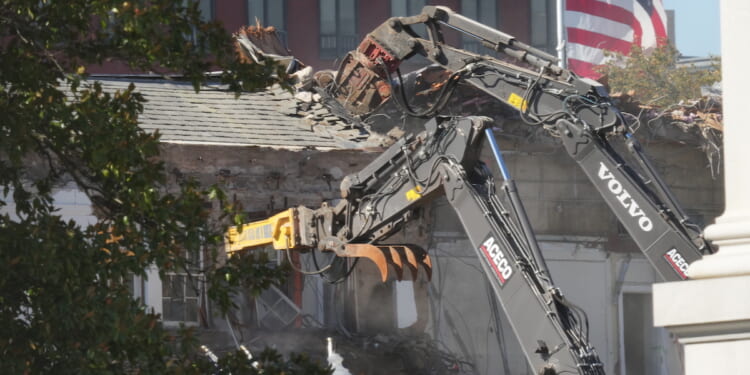
On Monday, President Donald Trump announced that “ground has been broken … to build the new, big, beautiful White House Ballroom.” That day, excavators began tearing into the East Wing — the section he had described as “completely separate” from the White House.
Images of the demolition spread almost instantly, showing heavy machinery ripping into the historic façade. The reaction was swift and furious, with critics accusing Trump of vandalizing a national landmark and accusing him of turning the People’s House into his own vanity project. By evening, the administration was already in damage-control mode, insisting that the project was a privately-funded “modernization” respectful of the building’s history.
Ground Broken
Trump’s announcement displayed his customary flair for both historic ambition and factual improvisation:
Completely separate from the White House itself, the East Wing is being fully modernized as part of this process, and will be more beautiful than ever when it is complete! For more than 150 years, every President has dreamt about having a Ballroom at the White House to accommodate people for grand parties, State Visits, etc. I am honoured to be the first President to finally get this much-needed project underway — with zero cost to the American Taxpayer! The White House Ballroom is being privately funded by many generous Patriots, Great American Companies, and, yours truly. This Ballroom will be happily used for Generations to come!
As outlined in the July 31 White House statement:
The White House is one of the most beautiful and historic buildings in the world, yet the White House is currently unable to host major functions honoring world leaders and other countries without having to install a large and unsightly tent approximately 100 yards away from the main building entrance.
The release went on to describe the planned ballroom as “a much-needed and exquisite addition of approximately 90,000 total square feet … with a seated capacity of 650 people.”
On Monday, Trump clarified that the capacity would be 999 people.
Demolition vs. Modernization
The blueprints of the planned ballroom make no effort to hide what’s happening,
White House state ballroom to be constructed at least partially in the East Wing.
The East Wing’s current footprint is about 8,360 square feet. The new ballroom is planned at 90,000 — more than ten times larger.
To expand something by that much, you have to make space for it first. And making space, in this case, means bulldozing part of the White House itself.
The administration prefers gentler language, calling the project a “modernization” that will leave the building “more beautiful than ever.” But this “beauty,” as Trump sees it, will come by way of destruction of what already exists. The video footage and images shows that in practice, the East Wing is stripped to its bones.
Trump’s claim that the East Wing is somehow “separate” from the White House is misleading at best. While the wing is not part of the presidential residence itself, it is a structural component of the White House complex, connected by corridors, utilities, and more than a century of shared history. Whatever separation exists is architectural only in theory and political in convenience.
Oversight has proved equally flexible. Demolition began without any public plan presented to the National Capital Planning Commission, the body that normally reviews federal construction. The Commission is currently closed amid the government shutdown, but the White House had no intention of consulting it in the first place. In September, staff secretary Will Scharf — who also chairs the same commission — claimed that approval wasn’t required because
the board does not have jurisdiction over demolition or site preparation work for buildings on federal property. “What we deal with is essentially construction, vertical build,” Scharf said.
Renovation, Trump Style
As the announcement echoed online, dramatic images showed machinery clawing through the façade and windows of the East Wing, ripping away historic stone and glass. The images were particularly striking given the president’s earlier assurance that the ballroom would “not interfere with the current building.” Trump said as much in July, stressing,
It’ll be near it but not touching it and pays total respect to the existing building, which I’m the biggest fan of.… It’s my favorite. It’s my favorite place. I love it.
However, on October 16, Trump told the donors financing the project exactly what would happen. Speaking at the White House dinner and gesturing toward the East Wing from the window, he explained,
We’ll collapse it over the next few days. It’s going to be demolished. Everything out there will come down, and we’ll be replacing it with one of the most beautiful ballrooms that you’ve ever seen.
Critics across the political spectrum called the project a vanity build — extravagant, tone-deaf, and out of step with national priorities during economic uncertainty.
The White House, never one to let a narrative stand unchallenged, struck back,
A lot of FAKE OUTRAGE over construction of the big, beautiful (and privately funded) White House Ballroom.
It then launched into a brisk history lesson:
Presidents have been renovating and expanding the White House for more than 100 years.
What followed was a list of “precedent”: Theodore Roosevelt’s West Wing, William Howard Taft’s Oval Office, FDR’s second floor to the West Wing and a swimming pool, Harry Truman’s interior rebuild, Richard Nixon’s bowling alley, and Barack Obama’s basketball court — all presented as proof that a current demolition is merely tradition.
But none of the previous expansions and renovations involved tearing down a section of the White House while publicly insisting on “non-interference.”
Corporate “Patriots”
For all the talk of “zero cost to the taxpayer,” the ballroom’s funding has come from some of the nation’s most influential corporations — the kind that rarely appear on donation lists without a return address.
At the aforementioned donor dinner last week, the guest list read less like a patriotic roll call and more like a Fortune 100 board meeting. Representatives from Amazon, Apple, Google, Meta, Palantir, Lockheed Martin, and Booz Allen Hamilton were among those reportedly present, joined by others such as R.J. Reynolds Tobacco, NextEra Energy, and T-Mobile. Between them, these companies hold tens of billions in federal contracts. Reportedly, the Adelson Family Foundation, founded by Trump megadonor Miriam Adelson, was also represented at the event.
The White House insists the project’s cost will be covered entirely by these “generous patriots.” But this generosity comes with a few accounting conveniences. The administration has not yet released a full list of donors or disclosed the size and structure of their contributions. Some reports suggest that parts of the funding will pass through nonprofit intermediaries, potentially allowing the donations to qualify as tax-deductible.
Officially, the ballroom is being built without public funds. In practice, the public will still pay — just indirectly, through the contracts, subsidies, and favorable access that tend to follow such “patriotic” enthusiasm.




![Hegseth Demands Fitness Requirements, Says 'Fat Troops' 'Not Who We Are' [WATCH]](https://teamredvictory.com/wp-content/uploads/2025/09/Hegseth-Demands-Fitness-Requirements-Says-Fat-Troops-Not-Who-We-350x250.jpg)






